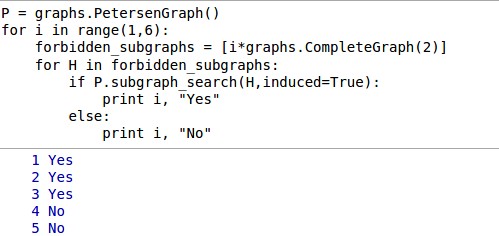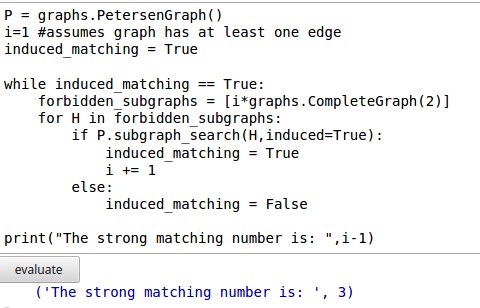Revision history [back]
 | 1 | initial version |
I'm unaware of anything built in to find the strong matching number. However, it's easy enough to put some code together. Sage is able to look for subraphs with subgraph_search. You can insist that the subgraph is induced as well. The Petersen graph has ten vertices so a strong matching could be at most 5. The for loop has i run from 1 to 5, the forbidden subgraphs are set to i*graphs.CompleteGraph(2) and then Sage looks for that subgraph.
P = graphs.PetersenGraph()
for i in range(1,6):
forbidden_subgraphs = [i*graphs.CompleteGraph(2)]
for H in forbidden_subgraphs:
if P.subgraph_search(H,induced=True):
print i, "Yes"
else:
print i, "No"
The result in a Sage Notebook is shown below. It indicates Sage found an induced matching on 1 edge, 2 edges, and 3 edges. It could not find one on 4 edges so, of course, it can't find one on five edges. This would mean the strong matching number of the Petersen graph is 3.

 | 2 | No.2 Revision |
I'm unaware of anything built in to find the strong matching number. However, it's easy enough to put some code together. Sage is able to look for subraphs with subgraph_search. You can insist that the subgraph is induced as well. The Petersen graph has ten vertices so a the strong matching number could be at most 5. The for loop has i run from 1 to 5, the forbidden subgraphs are set to i*graphs.CompleteGraph(2) and then Sage looks for that subgraph.
P = graphs.PetersenGraph()
for i in range(1,6):
forbidden_subgraphs = [i*graphs.CompleteGraph(2)]
for H in forbidden_subgraphs:
if P.subgraph_search(H,induced=True):
print i, "Yes"
else:
print i, "No"
The result in a Sage Notebook is shown below. It indicates Sage found an induced matching on 1 edge, 2 edges, and 3 edges. It could not find one on 4 edges so, of course, it can't find one on five edges. This would mean the strong matching number of the Petersen graph is 3.

 | 3 | No.3 Revision |
I'm unaware of anything built in to find the strong matching number. However, it's easy enough to put some code together. Sage is able to look for subraphs with subgraph_search. You can insist that the subgraph is induced as well. The Petersen graph has ten vertices so the strong matching number could be at most 5. The for loop has i run from 1 to 5, the forbidden subgraphs are set to i*graphs.CompleteGraph(2) and then Sage looks for that subgraph.
P = graphs.PetersenGraph()
for i in range(1,6):
i=1 #assumes graph has at least one edge
induced_matching = True
while induced_matching == True:
forbidden_subgraphs = [i*graphs.CompleteGraph(2)]
for H in forbidden_subgraphs:
if P.subgraph_search(H,induced=True):
print i, "Yes"
induced_matching = True
i += 1
else:
print i, "No"
induced_matching = False
print("The strong matching number is: ",i-1)
The result in a Sage Notebook is shown below. It indicates Sage found an induced matching on 1 edge, 2 edges, and 3 edges. It could not find one on 4 edges so, of course, it can't find one on five edges. This would mean the strong matching number of the Petersen graph is 3.below.


